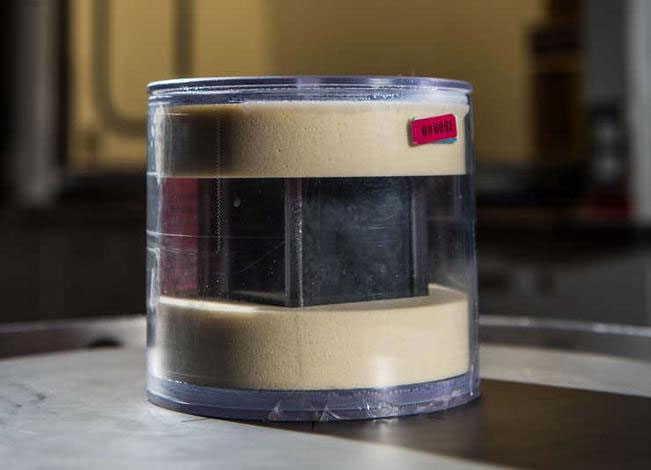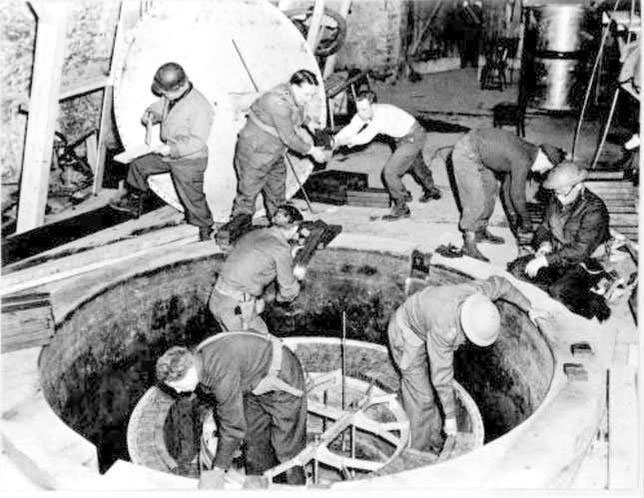A research team at the Pacific Northwest National Laboratory in Washington is working to determine the origins of mysterious uranium blocks in the United States. These radioactive blocks were used by the Nazis to develop their nuclear program. Using nuclear forensic techniques, the team has made progress in identifying the source of this radioactive material. So far, no one has been able to definitively trace the journey of these radioactive blocks to America.

The cubic uranium block is preserved in a protective case at the Pacific Northwest National Laboratory, Washington (Photo: Andrea Starr/Pacific Northwest National Laboratory)
Earlier this week, the research team’s findings were presented at a seminar of the American Chemical Society. From 1939 to 1945, the Nazis developed their own nuclear program with two research groups. The first group was led by Werner Heisenberg, and the second was directed by Kurt Diebner. Both groups designed and constructed nuclear reactors with the goal of creating atomic bombs. After the war, many radioactive blocks were sent to the U.S. and distributed to universities and private facilities through both official and unofficial channels.
Overall, these radioactive blocks lack a clear historical origin. This means we cannot trace how many owners they passed through and when the transfers occurred. The research team estimates that there were about 1,000 to 1,200 radioactive blocks in Nazi nuclear reactors, but only 12 have been found to date. Currently, the team is working to trace the origins of the radioactive block found in Washington and a few other locations.
“We are not certain that these radioactive blocks belong to the Nazi nuclear program, so we want to confirm this first. After that, we want to compare the differences between the radioactive blocks to see if they can be classified according to the specific research groups that created them,” said Jon Schwantes, the principal investigator of the project, in a statement from the American Chemical Society.
German scientists focused on researching nuclear fission, a process that involves bombarding a heavy nucleus with neutrons, causing it to become unstable and decay while releasing energy. Heisenberg’s group hoped to manipulate a uranium block immersed in heavy water to produce plutonium for atomic bombs. The Nazi radioactive blocks are cubic, with each side measuring about 5 cm, suspended by cables at three corners and submerged in water; fortunately, this experiment failed.
After that, they no longer had enough time to continue their research. In 1945, British and American forces obtained uranium blocks related to this experiment and sent approximately 600 blocks back to the U.S. Some uranium blocks have disappeared since then. Others, like the uranium block in Washington, have unclear origins. A study conducted at the University of Maryland provided an intriguing note published in 2019 by current project collaborators. The note simply stated: “Taken from the reactor that Hitler attempted to build. Gift from Ninninger.”
Ninninger (misspelled in the note) was the temporary manager of the Manhattan Project at Murray Hill, Manhattan. He gifted a cubic block (acquired from his workplace) to a friend, who then passed it on to another friend, and it eventually reached the current project collaborator, Timothy Koeth, on his birthday.

U.S. and British troops dismantling a Nazi nuclear reactor under construction in Haigerloch in April 1945 (Photo: Wikimedia Commons)
The research team used radioactive measurements to determine the age of three uranium blocks, measuring the amount of radioactive material and the substances they decay into. Since the uranium blocks began to decay when they were cast, they now contain a certain amount of thorium and protactinium.
Brittany Robertson, a chemist at the Pacific Northwest National Laboratory, along with another collaborator, used radioactive measurements to identify each element present in the radioactive block and their relative concentrations. The results could help scientists determine when these uranium blocks were created. Additionally, impurities in the radioactive block may contain traces of other rare earth elements, information that could help scientists locate where the uranium was mined.
“The primary goal is simply to confirm the origins of the three radioactive blocks we are studying, estimating their age to be around the early to mid-1940s,” Schwantes told Gizmodo via email. “If our dating method is extremely accurate, it could help determine whether these radioactive blocks came from Heisenberg’s lab or Diebner’s since their research dates differ (about a year apart).”
Radioactive measurements work within a short timeframe, allowing researchers to know that the radioactive blocks were created around the 1940s. They cannot confirm whether these blocks belong to Heisenberg’s lab or Diebner’s (or neither, though this is unlikely). Schwantes noted that finding the origins of the radioactive blocks is “a long-term goal,” and at the very least, the team needs to confirm that these radioactive blocks are from the Nazis—something they have always believed to be true but have not yet had enough information to verify.



















































